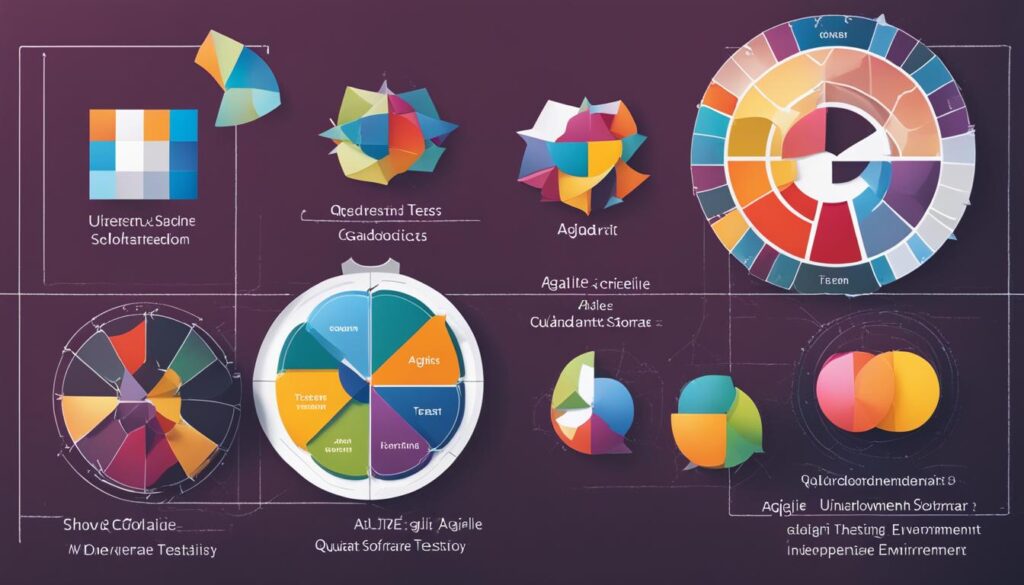Advanced Topics in SQA
Exploring Agile Testing Methodologies | Best Practices

Agile testing has become a crucial component of software development, ensuring the delivery of quality products. To truly understand agile testing, one must be familiar with the principles and ideas at the heart of Agile development practices. Central to the philosophy of agile testing is the emphasis on continuous testing, considering it as vital as the act of writing code. This testing philosophy aligns perfectly with the agile software development approach, promoting the idea of keeping a testing strategy active throughout the entire process of development.
In the world of Agile testing, every time a new update is made to the code, the test team gets their hands on it, providing continuous feedback directly to the developers. This iterative approach allows for the early identification of bugs and issues, leading to faster and more efficient software development. Agile testing encompasses various testing techniques and methodologies that align with Agile principles and promote collaboration, continuous improvement, and responsiveness to change.
- Agile testing is a crucial part of software development, testing, and quality assurance.
- It operates under the philosophy of continuous testing and early bug detection.
- Agile testing involves testing that is appropriate for an agile software development environment.
- It emphasizes collaboration, continuous improvement, and responsiveness to change.
- There are various testing techniques and methodologies in Agile testing, such as acceptance test-driven development, behavior-driven development, and exploratory testing.
What is Agile Software Development?
Agile software development is a modern approach to building software that emphasizes flexibility, collaboration, and responsiveness. It deviates from traditional development techniques by focusing on the key principles of agile software development, which prioritize people over processes and tools, a working piece of software over extensive documentation, ongoing collaboration with customers over rigid contracts, and adaptability to change rather than following a predetermined plan.
In Agile methodology, such as Scrum or Kanban, the entire team works together in a collaborative manner. They break down the project into smaller, manageable tasks and continuously add new features as they progress. This iterative approach allows for frequent feedback, problem-solving, and course correction, leading to a more efficient and effective software development lifecycle.
Implementing agile testing methods is crucial in ensuring the quality of the software being developed. By integrating testing throughout the development process, teams can identify and address issues early on, resulting in a higher quality end product. Continuous testing, an essential component of agile software development, enables teams to catch and fix bugs promptly, reducing the need for expensive rework later on.

Agile software development enables us to stay responsive to change and deliver valuable software efficiently. It’s not just about the finished product; it’s about the ongoing collaboration and iterative improvements that lead to success.
Key Principles of Agile Software Development
- Focus on people rather than processes and tools
- Prioritize a working piece of software over extensive documentation
- Emphasize ongoing collaboration with customers over fixed contracts
- Be responsive to change rather than sticking to a rigid plan
The agile methodology embraces the dynamic nature of the software development process. It empowers teams to adapt, learn, and evolve, resulting in software that better meets the needs of its users.
Agile Testing Methodology
In an agile software development environment, Agile testing methodology plays a crucial role. This methodology focuses on continuous testing, where testing is seamlessly integrated into the development process. By identifying bugs early and frequently, it helps ensure the quality of the software product. In contrast, traditional testing methods often involve waiting until the end of the development cycle, resulting in costly bug fixes.
With agile testing methodology, testing takes place at every stage of development, including after code merges, changes, and movements. This proactive approach allows for the swift identification of problems and ensures progress towards the final release. By incorporating testing throughout the development lifecycle, agile testing helps prevent major issues and provides opportunities for timely bug fixes and improvements.
By implementing agile testing methodology, development teams can maintain a high level of software quality, reduce the overall cost of bug fixing, and improve the efficiency of the development process.
Principles of Agile Testing
Agile testing is driven by a set of principles that guide our testing practices. These principles enable us to deliver high-quality products while keeping the customer’s needs at the forefront. By following these principles, we can ensure that our testing efforts align with the Agile methodology and contribute to the overall success of the development process.
- Test earlier and more frequently: In Agile testing, we believe in testing as early as possible and throughout the development cycle. By doing so, we can identify and address issues in a timely manner, reducing the risk of defects slipping into the final product.
- Automate a greater proportion of tests: Automation plays a vital role in Agile testing. By automating repetitive and time-consuming tests, we can increase efficiency and accuracy, allowing us to focus more on exploratory and value-added testing.
- Provide continuous feedback: Continuous feedback is essential in Agile development. By providing timely and constructive feedback, we can help improve the product and ensure that it meets the customer’s expectations. This feedback loop helps in identifying and addressing any issues or concerns early on.
- Deliver value to the customer: The ultimate goal of Agile testing is to deliver a product that adds value to the customer. By testing with the end user in mind, we can focus on improving usability, functionality, and overall user experience.
- Enable face-to-face communication: Effective communication is a cornerstone of Agile testing. By facilitating direct and frequent communication between team members, we can minimize misunderstandings, reduce errors, and enhance collaboration and problem-solving capabilities.
- Keep it simple: Agile testing advocates for simplicity in our testing approach. By focusing on necessary tests and avoiding unnecessary complexity, we can streamline our efforts and ensure that testing remains efficient and effective.
- Practice continuous improvement: Agile testing is a continuous learning process. By regularly reviewing and improving our testing practices, we can enhance our skills, processes, and overall testing capabilities.
- Respond to change: Agile testing embraces change and adapts to evolving requirements. By being flexible and responsive to changes in the project, we can effectively address new challenges and ensure that testing aligns with the development process.
- Self-organize: Agile testing encourages self-organization within the team. By fostering a culture of collaboration and empowerment, we can promote active problem-solving, creativity, and ownership of testing activities.
- Focus on end users: The end user is at the center of Agile testing. By prioritizing the needs and expectations of the end user, we can develop and deliver a product that is user-centric, usable, and meets their specific requirements and goals.
By adhering to these principles of Agile testing, we can ensure that our testing efforts align with the Agile methodology and contribute to the delivery of high-quality products that meet the needs of our customers.

Profile of an Agile Tester
An agile tester plays a crucial role in the development process, ensuring the quality of the software being built. What sets them apart is their unique profile, encompassing a diverse range of skills and qualities. Let’s explore the key attributes of an agile tester:
1. Communication Skills
Effective communication is vital for an agile tester to collaborate successfully with team members. From interacting with developers to understanding client requirements, strong communication skills facilitate smooth project coordination, leading to better outcomes.
2. Technical-Based Skillset
An agile tester possesses a versatile technical skillset, encompassing areas such as programming languages, databases, and operating systems. This technical proficiency allows them to understand the software under development and skillfully execute various testing techniques.
3. Familiarity with Testing Tools
Using cutting-edge testing tools enhances an agile tester’s efficiency and effectiveness. Whether it’s test automation frameworks, bug tracking systems, or performance testing tools, familiarity with these tools enables testers to optimize their workflow and deliver high-quality results.
4. Collaboration and Adaptability
The ability to collaborate seamlessly with developers, product owners, and other stakeholders is essential for an agile tester. A strong collaborative approach, coupled with adaptability to changing project demands and priorities, allows testers to navigate evolving requirements effectively.
5. Liaising with Team Members
An agile tester excels at building strong relationships within the project team. From clarifying requirements with business analysts to seeking clarification from developers, effective liaison ensures accurate testing and alignment with project goals.
6. Experience in Exploratory Testing
Exploratory testing is a vital aspect of agile testing, requiring testers to think creatively and uncover potential issues. Agile testers with broad experience in exploratory testing can identify unique bugs, provide valuable feedback, and ultimately contribute to system improvement.
“Being an agile tester means bringing together technical expertise, exceptional communication skills, and a passion for driving quality. Our role is crucial in ensuring that the software meets user expectations and enables successful project delivery.”
By embodying these qualities, an agile tester contributes significantly to the development process, adding value to the software being built and ensuring its quality. Now that we understand what makes an agile tester, let’s explore the different types of testing methodologies used in agile development.
Comparison of Agile Testing Qualities
| Qualities | Description |
|---|---|
| Communication Skills | Effective communication facilitates collaboration and understanding among team members. |
| Technical-Based Skillset | A diverse range of technical skills allows for comprehensive testing and understanding of the software under development. |
| Familiarity with Testing Tools | Knowledge and proficiency in various testing tools enhance efficiency and effectiveness in executing test cases. |
| Collaboration and Adaptability | The ability to work well with others and adapt to changing project needs ensures successful coordination and delivery. |
| Liaising with Team Members | Effective communication and collaboration with team members across different roles facilitate smooth project execution. |
| Experience in Exploratory Testing | A broad experience in exploratory testing enables the identification of unique bugs and the provision of valuable feedback. |
Types of Testing in Agile
Agile testing encompasses various types of testing methodologies. Four popular ones are acceptance test-driven development (ATDD), behavior-driven development (BDD), exploratory testing, and session-based testing.
Acceptance test-driven development (ATDD) involves collaboration between customers, developers, and testers to create acceptance tests from the customer’s point of view. By involving stakeholders from the outset, ATDD ensures that the software meets the desired user requirements and functionality.
Behavior-driven development (BDD) enhances test-driven development by focusing on identifying correct business outcomes and testing based on those outcomes. BDD encourages detailed collaboration between developers, testers, and stakeholders to improve overall software quality and ensure that the software aligns with business goals.
Exploratory testing is a cyclical method where tests are generated as the product is explored. Testers have the freedom to investigate the software, identify unique bugs, and provide timely feedback to the development team. This approach allows for creativity and adaptability in uncovering defects.
Session-based testing adds structure to exploratory testing. Testers create test sessions with specific charters and debriefing sessions to consolidate their findings. This method offers a systematic approach to exploratory testing, improving efficiency and maintaining focus on identified goals.

| Testing Methodology | Description |
|---|---|
| Acceptance Test-Driven Development (ATDD) | Collaborative creation of acceptance tests from the customer’s perspective |
| Behavior-Driven Development (BDD) | Identifying correct business outcomes and testing based on those outcomes |
| Exploratory Testing | Unstructured testing where tests are generated as the product is explored |
| Session-Based Testing | Structured exploratory testing with specific charters and debriefing sessions |
12 Best Agile Testing Practices
Implementing the best agile testing practices can greatly enhance your testing process and ensure the delivery of high-quality software. By following these practices, you can maintain code austerity, repeat testing often, communicate effectively with developers, keep the goal in mind, concentrate on a single functionality, know the application, and focus on delivering quality. Let’s explore each practice in detail:
- Maintain code austerity: Simplify testing and future upgrades by keeping the codebase clean and free from unnecessary complexity.
- Repeat testing often: Catch bugs early by running tests frequently throughout the development process.
- Communicate with developers: Provide feedback and collaborate closely with the development team to resolve defects and improve the software.
- Keep the goal in mind: Align testing efforts with the overall project goal to ensure that you are testing the right aspects of the software.
- Concentrate on a single functionality: Thoroughly test each individual functionality to ensure its reliability, performance, and usability.
- Know the application: Familiarize yourself with the application through documentation and interactions with team members to gain a deeper understanding of its requirements and intricacies.
- Focus on quality: Treat quality assurance as a team responsibility and strive for continuous improvement in every aspect of the testing process.
- Implement agile test procedures: Follow established agile testing techniques and methodologies to improve the quality of deliverables.
- Estimate user stories: Plan testing efforts by estimating the testing effort required for each user story.
- Test user stories: Develop and execute tests based on the acceptance criteria of user stories, adapting them as the story evolves.
- Introduce exploratory testing: Uncover unique defects and gain insights into the software’s behavior by conducting exploratory testing sessions.
- Initiate session-based testing: Structure your exploratory testing efforts by creating test sessions with specific charters and debriefing sessions to consolidate findings.
By incorporating these best practices into your agile testing process, you can ensure the delivery of high-quality software that meets user expectations and drives business success.

Three Benefits of Agile Testing Practices
Agile testing practices offer three key benefits. First, they lead to higher quality products by detecting and addressing defects early in the development process and incorporating continuous feedback from the end users. This ensures that any issues are identified and resolved promptly, resulting in software that meets the highest standards of quality and reliability.
Second, agile testing enables fast delivery by expediting the development cycle and adapting to changing market demands. The iterative nature of agile development allows for frequent releases, ensuring that valuable features and updates are delivered to customers in a timely manner. This accelerated delivery cycle helps organizations stay ahead of the competition and meet the ever-changing needs of their users.
Third, agile testing promotes team cohesion by fostering collaboration and creating a productive work environment. Agile teams work closely together, with testers being involved from the beginning of the development process. This collaboration not only improves communication and knowledge sharing, but also enhances the overall synergy among team members. By working together towards a common goal, agile teams build stronger relationships and achieve better outcomes.
Overall, the benefits of agile testing practices include higher quality products, fast delivery, and improved team cohesion. By implementing these practices, organizations can enhance their software development process, deliver superior products, and stay competitive in today’s fast-paced market.
Agile Testing Quadrants
The Agile Testing Quadrants model provides a taxonomy to guide the planning and execution of testing activities in agile development. These quadrants categorize tests into technology-facing tests (Q1 and Q4) and business-facing tests (Q2 and Q3), each with its own focus and considerations.
Technology-facing tests (Q1 and Q4)
Technology-facing tests in Q1 and Q4 mainly involve automated testing techniques. These tests focus on the technical aspects of the system, ensuring that the underlying technology functions as intended. Some examples of technology-facing tests include:
- Unit tests
- API tests
- Functional tests
- Performance tests
- Security tests
Business-facing tests (Q2 and Q3)
Business-facing tests in Q2 and Q3 can involve both automated and manual testing approaches. These tests primarily focus on the business requirements and user experience. Some examples of business-facing tests include:
- Functional tests
- Exploratory tests
- Usability tests
- User acceptance tests
- Alpha/beta tests
The Agile Testing Quadrants help teams strategize their testing approach based on the skills and resources available. By identifying the quadrant that a specific test falls into, teams can better plan and prioritize their test activities to ensure comprehensive and effective testing throughout the agile development process.
| Quadrant | Focus | Test Examples |
|---|---|---|
| Q1 – Technology-facing tests | Technical aspects of the system |
|
| Q2 – Business-facing tests | Business requirements |
|
| Q3 – Business-facing tests | User experience |
|
| Q4 – Technology-facing tests | Technical aspects of the system |
|

Agile Methodology in Testing
When it comes to testing in an agile software development environment, the traditional role-based approach is replaced by an activity-based approach that involves all members of a cross-functional agile team. Testing becomes an integral part of the development process, with continuous testing, continuous delivery, and continuous integration playing crucial roles.
In agile development, user stories take center stage, helping teams focus on requirements and ensuring constant interaction with the business stakeholders. By breaking down the software functionality into manageable user stories, teams can prioritize and deliver valuable features incrementally.
Two popular frameworks used in agile development are Scrum and Kanban. Scrum follows an iterative approach, with short sprints and regular meetings to plan and review progress. Kanban, on the other hand, emphasizes continuous flow, allowing teams to visualize and manage their work in a structured manner.
Agile Methodology Components:
- Continuous Testing: Testing is conducted throughout the development process, ensuring any issues are identified early and resolved promptly.
- Continuous Delivery: The deployment of software updates is automated and done in small increments, enabling faster and more frequent releases.
- Continuous Integration: Changes made to the codebase are integrated and tested regularly, promoting collaboration and reducing the risk of conflicts during integration.
Incorporating agile methodology in testing enables teams to be more responsive, adaptive, and efficient in delivering high-quality software. By embracing a cross-functional approach, organizations can achieve better collaboration, faster feedback loops, and improved customer satisfaction.
Let’s take a closer look at the benefits of agile testing practices in the next section.
Conclusion
Agile testing methodologies have revolutionized software development, testing, and quality assurance. By embracing agile principles and implementing best practices, development teams can elevate software quality, accelerate the development cycle, and deliver top-notch products that meet customer requirements. Agile testing fosters continuous testing and collaboration among team members, leading to enhanced efficiency, superior product quality, and increased customer satisfaction. It is crucial for organizations to adopt agile testing methodologies to remain competitive in the fast-paced and ever-evolving software development landscape.
In conclusion, agile testing methodologies offer significant benefits to software development teams. By integrating testing throughout the development process, teams can identify and rectify issues early on, ensuring a high-quality end product. Continuous collaboration and feedback among team members lead to efficient workflows and seamless integration of testing into agile development cycles. This ultimately results in improved productivity, better product quality, and increased customer satisfaction. Agile testing methodologies have become indispensable in today’s software development industry, enabling organizations to meet customer demands and stay ahead of the competition.
To thrive in the dynamic software development landscape, organizations must embrace agile testing methodologies. By adopting these methodologies, teams can drive innovation, improve time-to-market, and deliver exceptional products that surpass customer expectations. Agile testing promotes a culture of continuous improvement, collaboration, and adaptability, enabling organizations to respond quickly to market changes and customer feedback. By leveraging agile testing methodologies, development teams can optimize their testing processes, enhance software quality, and achieve greater success in the ever-evolving world of software development.
The Agile development methodology focuses on working collaboratively, prioritizing a working piece of software over detailed documentation, and being responsive to change.
Agile testing methodology is testing that occurs in an agile software development environment, where testing is integrated continuously throughout the development process to identify and address defects early. The principles of agile testing include testing earlier and more frequently, automating a greater proportion of tests, providing continuous feedback, delivering value to the customer, enabling face-to-face communication, keeping it simple, practicing continuous improvement, responding to change, self-organizing, and focusing on end users.
An agile tester possesses communication skills, technical-based skillset, familiarity with testing tools, collaboration skills, adaptability, ability to liaise with team members, broad experience in exploratory testing, results-oriented personality, and a passion for delivering value in business.
The types of testing in Agile include acceptance test-driven development (ATDD), behavior-driven development (BDD), exploratory testing, and session-based testing.
The best agile testing practices include maintaining code austerity, repeating tests often, communicating with developers, keeping the goal in mind, concentrating on a single functionality, knowing the application, focusing on quality, implementing agile test procedures, estimating user stories, testing user stories, introducing exploratory testing, and initiating session-based testing.
The benefits of agile testing practices include higher quality products, fast delivery, and improved team cohesion. The Agile Testing Quadrants model is a taxonomy that guides the planning and execution of testing activities, dividing tests into technology-facing tests and business-facing tests.
Agile methodology shifts from a role-based approach to testing to an activity-based approach that involves all members of a cross-functional agile team, incorporating continuous testing, continuous delivery, and continuous integration.
Yes, by following agile testing methodologies, development teams can enhance software quality, speed up the development cycle, and deliver high-quality products that meet customer requirements.
Organizations can implement agile testing methodologies by embracing agile principles, following best practices, and fostering a collaborative and iterative approach to software development and testing.
Agile testing methodologies are important in software development as they enable continuous testing, collaboration among team members, and early identification and resolution of defects, resulting in improved efficiency, product quality, and customer satisfaction.FAQ
What is the Agile development methodology?
What is agile testing methodology?
What are the principles of agile testing?
What are the characteristics of an agile tester?
What are the types of testing in Agile?
What are the best agile testing practices?
What are the benefits of agile testing practices?
What is the Agile Testing Quadrants model?
How does Agile methodology impact testing?
Can agile testing methodologies improve software quality?
How should organizations implement agile testing methodologies?
What is the importance of agile testing methodologies in software development?
At the helm of our content team is Amelia, our esteemed Editor-in-Chief. Her extensive background in technical writing is matched by her deep-seated passion for technology. Amelia has a remarkable ability to distill complex technical concepts into content that is not only clear and engaging but also easily accessible to a wide range of audiences. Her commitment to maintaining high-quality standards and her keen understanding of what our audience seeks are what make her an invaluable leader at EarnQA. Under Amelia’s stewardship, our content does more than just educate; it inspires and sets new benchmarks in the realm of QA education.
Advanced Topics in SQA
Unveiling the Top Personality Traits of Successful Software Quality Assurance Engineers
Software Quality Assurance Engineers need attention to detail, problem-solving skills, and a methodical approach. Their traits include analytical thinking, patience, communication, and teamwork.

There’s a widely held perception that certain personality traits are integral to the success of software quality assurance engineers in their roles.
But what exactly are these traits, and how do they contribute to their effectiveness in ensuring the quality of software products?
As we explore this topic further, we'll uncover the specific personality characteristics that set software quality assurance engineers apart and contribute to their ability to excel in their field.
Key Takeaways
- Software Quality Assurance Engineers possess strong investigative and analytical skills, allowing them to thoroughly analyze information and dissect complex issues to find practical solutions.
- They prioritize fair outcomes and ethical practices, value positive relationships within teams, and demonstrate concern for the well-being of others.
- Attention to detail is a key trait for Software Quality Assurance Engineers, as they meticulously examine software requirements, identify and report bugs with precision, and accurately document test results.
- Effective communication skills are essential, including active listening, providing feedback, adapting communication style and tone, and building rapport and trust through open and honest communication.
- Adaptability and flexibility are crucial traits for Software Quality Assurance Engineers, as they embrace change in the dynamic software development environment, switch between different tasks and projects quickly, approach problem-solving from various angles, and adjust to evolving project requirements and testing methodologies.
Investigative and Analytical
In our role as Software Quality Assurance Engineers, we employ our keen investigative and analytical skills to meticulously unravel complexities and derive efficient solutions. Our curious and inquisitive nature drives us to question and explore ideas, allowing us to thoroughly analyze information.
We find enjoyment in delving deep into problem-solving, driven by a strong desire to understand how things work. Our analytical mindset enables us to dissect complex issues and find practical solutions, making us well-suited for the demands of software quality assurance.
We possess a preference for investigating and examining information in detail, which allows us to uncover potential issues and ensure the delivery of high-quality software products. Spending time alone, thinking and analyzing, is where we thrive, as it provides us with the necessary focus to meticulously scrutinize every aspect of the software under examination.
Our dedication to investigative and analytical approaches ensures that we maintain a steadfast commitment to delivering excellence in software quality assurance.
Social Responsibility and Agreeableness

Demonstrating a high level of social responsibility and agreeableness, software quality assurance engineers prioritize fair outcomes, ethical practices, and positive relationships within their teams. Their strong sense of social responsibility leads them to value fair treatment and ethical practices, ensuring that the software they work on is of high quality and fairness. They're driven by a concern for the well-being of others, striving to create products that benefit all users.
Moreover, their high level of agreeableness enables them to navigate interpersonal relationships with ease. They're sensitive to the needs and feelings of others, valuing cooperation and collaboration. This trait fosters a harmonious environment within their teams, where positive relationships are nurtured, and conflicts are managed effectively. Their willingness to compromise and find mutually beneficial solutions further demonstrates their agreeableness, contributing to the overall success of the team.
In essence, the combination of social responsibility and agreeableness equips software quality assurance engineers with the mindset and skills needed to ensure fair, ethical, and high-quality outcomes in their work while fostering positive and productive relationships within their teams.
Strong Attention to Detail
With their meticulous attention to detail, software quality assurance engineers meticulously examine software requirements, identify and report bugs with precision, and ensure accurate documentation of test results. This strong attention to detail is a fundamental trait that allows quality assurance engineers to excel in their roles.
Their organized and detail-oriented nature enables them to follow established procedures and guidelines while maintaining a keen focus on accuracy and precision. This meticulous approach extends to their thorough examination of software functionality, enabling them to identify potential areas of improvement with precision and thoroughness.
The reliability exhibited by software quality assurance engineers is evident in their careful execution of each step in the testing process. Their meticulous attention to detail also comes to the forefront in the performance of thorough regression testing, ensuring the stability and quality of software products.
This unwavering commitment to precision and accuracy underscores the critical role that strong attention to detail plays in the work of software quality assurance engineers.
Effective Communication Skills

Effective communication skills are essential for software quality assurance engineers to collaborate efficiently and ensure the accuracy and clarity of information exchange within the team. As software testers, we must actively listen and provide feedback to guarantee understanding. Clarity and conciseness in conveying information help us avoid misunderstandings and confusion. Furthermore, being aware of non-verbal cues and body language is crucial for effective communication, allowing us to adapt our communication style and tone based on the audience and situation, thus enhancing our effectiveness. Building rapport and trust through open and honest communication fosters positive relationships and teamwork, which are vital in the field of software quality. To better illustrate the importance of effective communication skills, let's explore the following table:
| Effective Communication Skills | Role in Software Quality |
|---|---|
| Active listening and feedback | Ensuring understanding |
| Clarity and conciseness | Avoiding misunderstandings |
| Non-verbal cues and body language | Enhancing communication |
| Adapting style and tone | Improving effectiveness |
| Rapport and trust building | Fostering positive teamwork |
Mastering effective communication skills is indispensable for software quality assurance engineers, as it underpins our ability to collaborate, ensure accuracy, and maintain clarity in information exchange.
Adaptability and Flexibility
We continually adapt to changing project requirements and testing methodologies as software quality assurance engineers, demonstrating our flexibility and agility in the dynamic software development environment. Our adaptability and flexibility are crucial in this fast-paced industry. Here are some ways we embody these traits:
- Embracing Change: We're open to new ideas, processes, and technologies, and willingly embrace change in the dynamic software development environment.
- Versatile Approach: We've the ability to quickly switch between different tasks and projects while maintaining high-quality standards.
- Problem-solving Agility: We approach problems from various angles and adapt our strategies based on the evolving nature of software development.
- Agile Mindset: We can pivot and shift focus as priorities change, while still maintaining a high level of attention to detail and quality in our work.
- Dynamic Adaptation: We're adept at adjusting to evolving project requirements and testing methodologies, ensuring that our work remains effective and efficient.
Our adaptability and flexibility enable us to thrive in the ever-changing landscape of software development, ensuring that we deliver high-quality results despite the challenges we encounter.
Frequently Asked Questions
What Is the Personality Type of a Quality Engineer?
We believe the personality type of a quality engineer embodies inquisitiveness, attention to detail, and a preference for structured environments. They tend to exhibit analytical thinking, problem-solving skills, and a high sense of social responsibility.
Valuing fair outcomes and ethical practices, they also tend to be agreeable, sensitive to the needs of others, and value cooperation. These traits contribute to their ability to excel in the field of software quality assurance engineering.
What Personality Traits Are Needed to Be a Software Engineer?
We value the personality traits necessary for software engineering, including curiosity, the ability to work independently, and a strong desire to understand complex systems.
Our focus on problem-solving and analytical thinking shapes the way we approach challenges in software development. These traits drive our pursuit of mastery and excellence in our work.
Our attention to detail and commitment to understanding how things work allow us to excel in the field of software engineering.
What Makes Someone a Great QA Engineer?
As QA engineers, we excel in attention to detail, analytical thinking, and problem-solving. Our mastery lies in our ability to ensure software quality through meticulous testing and investigation.
We prioritize structured environments and efficiency, valuing order in our work. Additionally, our strong communication and collaboration skills drive our proactive approach to professional growth.
Our dedication to ethical practices and fair outcomes sets us apart as great QA engineers.
What Is the Personality of a QA Tester?
We find that the personality of a QA tester is marked by inquisitiveness, attention to detail, and a preference for structured environments. Our investigative and conventional approach aligns with our traits, making us thorough and organized in our work. We value fairness and cooperation, and our conscientiousness and openness contribute to our success in this role.
This combination of traits allows us to excel in analytical thinking and problem-solving within the QA testing domain.
Conclusion
In conclusion, software quality assurance engineers embody a unique blend of investigative and analytical skills, social responsibility, strong attention to detail, effective communication, and adaptability.
They're like a well-oiled machine, meticulously examining every part to ensure smooth operation.
Their commitment to excellence and continuous improvement sets them apart as essential contributors to the success of software products.
Randy serves as our Software Quality Assurance Expert, bringing to the table a rich tapestry of industry experiences gathered over 15 years with various renowned tech companies. His deep understanding of the intricate aspects and the evolving challenges in SQA is unparalleled. At EarnQA, Randy’s contributions extend well beyond developing courses; he is a mentor to students and a leader of webinars, sharing valuable insights and hands-on experiences that greatly enhance our educational programs.
Advanced Topics in SQA
Unlock Your Career Potential: How to Become a Software Quality Assurance Tester
Interested in becoming a Software Quality Assurance Tester? Here's your guide! Learn the skills, certifications, and steps to kickstart your career in software quality assurance testing.

The data speaks for itself – the Bureau of Labor Statistics forecasts a 9% growth in the need for software quality assurance testers over the coming decade.
But how does one actually step into this role and excel in it? While it may seem like a straightforward path, the intricacies of becoming a software quality assurance tester are multifaceted and require a blend of education, practical experience, and specific skill sets.
Join us as we unravel the key steps and insights into navigating this career path and thriving in the dynamic world of software testing.
Key Takeaways
- A bachelor's degree in computer science provides fundamental knowledge for a software quality assurance tester.
- Gaining practical experience through internships, open-source projects, and beta testing programs is valuable in becoming a QA tester.
- Pursuing certifications such as ISTQB or CSTE demonstrates expertise and proficiency in software testing.
- Developing strong analytical, problem-solving, and communication skills, as well as staying updated with industry trends, are crucial for success in the role of a QA tester.
Understanding the Role of a QA Tester
How does a QA tester work with software or websites to ensure proper functionality through manual and automated tests?
A QA tester plays a crucial role in the software development process by meticulously testing the functionality, performance, and user experience of software and websites. Through manual testing, they meticulously verify each feature and component to identify bugs and ensure that the software meets quality standards.
Additionally, they employ automated testing tools to efficiently conduct repetitive tests and validate the software's functionality across different scenarios. This meticulous approach to testing helps in identifying and addressing issues before the product release, thereby safeguarding the brand reputation and ensuring compliance with industry regulations and standards.
Furthermore, the role of a QA tester is pivotal in enhancing product safety, efficiency, and overall quality. By engaging in various types of testing such as unit testing, integration testing, system testing, performance testing, regression testing, and user acceptance testing, QA testers contribute significantly to the overall quality assurance of software products.
The job demands analytical thinking, problem-solving skills, and familiarity with different software testing models, making it a career path that requires a high degree of skill and expertise.
Essential Education and Training

Playing a pivotal role in software development, a QA tester requires essential education and training to excel in the field. To become a proficient quality assurance tester, individuals should consider the following steps:
- Educational Foundation: Attaining a bachelor's degree in computer science, software engineering, or a related field provides the fundamental knowledge needed to understand the intricacies of the software development lifecycle, equipping individuals with a strong technical background.
- Practical Experience: Gaining hands-on skills through internships or entry-level positions in software testing is invaluable. Practical experience allows individuals to apply theoretical knowledge to real-world scenarios, enhancing their understanding of the field.
- Certifications and Continuous Learning: Pursuing certifications such as ISTQB or CSTE demonstrates expertise and commitment to quality assurance. Additionally, continuous learning through workshops, seminars, and online courses is essential for staying updated with industry trends and refining skills.
Obtaining the necessary education, practical experience, and certifications, while continuously seeking professional development opportunities, is crucial for individuals aspiring to thrive in tech jobs as software testers.
Gaining Relevant Experience
To gain relevant experience in software testing, individuals can pursue internships, contribute to open-source projects, participate in beta testing programs, volunteer for quality assurance initiatives, and assist in creating and executing test plans and cases for software projects. Gaining hands-on experience is crucial in the tech industry, and there are various avenues to achieve this. For instance, joining open-source projects or beta testing programs allows individuals to work on real-world testing scenarios and build a portfolio of their work. Additionally, volunteering for quality assurance initiatives within their current organization or as part of a project team can provide valuable exposure to different aspects of software quality assurance. Assisting in creating and executing test plans and cases for software projects is another effective way to gain practical experience in testing and understanding the nuances of QA testing. Moreover, individuals can consider pursuing a coding bootcamp or getting certified to enhance their technical skills and increase their chances of securing relevant experience during the job search process.
| Pros | Cons |
|---|---|
| Practical, hands-on learning experience | May require time commitment |
| Exposure to real-world testing scenarios | Competitive internships |
| Opportunity to build a portfolio | Limited compensation in internships |
| Enhanced technical skills development | Limited availability of volunteer projects |
| Networking opportunities | Potential for repetitive tasks |
Acquiring Relevant Certifications

When considering the acquisition of relevant certifications for software quality assurance testing, it's essential to research and identify industry-recognized certifications such as ISTQB or CSTE. These certifications hold significant weight in the industry and are often sought after by employers when hiring Quality Assurance Analysts and Software testers.
To effectively pursue these certifications, one should consider the following:
- Enroll in Training Programs or Online Courses: Seek out specialized training programs or online courses that are tailored to prepare individuals for the certification exams. These courses often cover the necessary technical skills and knowledge required to excel in the field.
- Gain Practical Experience: Practical application of learned concepts in real-world scenarios is crucial for reinforcing understanding and skill development. It's essential to gain hands-on experience in testing various software applications to demonstrate proficiency.
- Utilize Study Materials and Practice Exams: Use study materials and practice exams to assess knowledge and readiness for certification testing. This allows individuals to gauge their preparedness and identify areas that may require further focus.
Key Skills for Success
Developing strong analytical and problem-solving skills is essential for identifying and addressing software defects effectively in the field of software quality assurance testing.
As software testers, we need to learn how to analyze complex systems, break down intricate problems, and devise effective solutions.
Furthermore, enhancing our communication abilities is crucial for clear reporting of testing results and collaborating with development teams.
As QA testers, we must be able to articulate our findings clearly and work closely with developers to ensure that issues are understood and resolved efficiently.
Acquiring proficiency in various software testing models and methodologies is also essential for adapting to diverse project requirements.
This involves continuous learning and development to stay current with the latest industry trends, technologies, and best practices.
Cultivating attention to detail and organizational skills is equally important to ensure thorough testing and efficient defect tracking.
As software QA testers, we need to be meticulous in designing and executing test scenarios, and in documenting and managing defects.
Frequently Asked Questions
How Do I Become a Software Quality Assurance Tester?
We become software quality assurance testers by obtaining a bachelor's degree in computer science or a related field.
We can also gain practical experience as developers or testers through internships or entry-level roles.
Developing proficiency in programming languages such as Java, C#, and SQL is crucial for success in this field.
Pursuing certifications like ISTQB Tester or CSTE can also enhance our qualifications.
Staying updated on industry trends and technologies is essential for staying competitive in the field.
This approach ensures a strong foundation, technical skills, and knowledge of best practices.
What Qualifications Do I Need to Be a QA Tester?
To be a QA tester, a strong foundation in computer science or related field is essential. We also need proficiency in programming languages, understanding of software development lifecycle, and familiarity with testing methodologies.
In addition, analytical thinking, attention to detail, and effective communication skills are crucial. A relevant degree and certifications such as ISTQB can enhance our qualifications.
Experience in software development or testing can also provide valuable insights.
How Long Does It Take to Become a QA Software Tester?
Becoming a QA Software Tester typically takes from a few months to a year, depending on individual background and learning pace.
It's crucial to have formal education in computer science or a related field and proficiency in programming languages like Java and C#.
Practical experience as a developer or tester, along with completing online courses or formal training, are valuable paths to becoming a QA Software Tester.
Continuous skill development and staying updated on industry trends are essential for success.
How Do I Start a Career in QA Testing?
We start a career in QA testing by obtaining a relevant degree and gaining practical experience through internships or junior positions.
Learning coding languages like Java, C#, HTML, and Python is essential.
Obtaining certifications, such as ISTQB Tester or CSTE, demonstrates our knowledge of best practices in QA testing.
Continuous learning and staying updated on industry trends are crucial for enhancing our knowledge and skills in QA testing.
Conclusion
In conclusion, becoming a software quality assurance tester requires a solid education in computer science, practical experience in testing, and potentially obtaining relevant certifications.
Are you ready to take the next step towards a rewarding career in QA testing? With the right skills and determination, you can excel in this field and contribute to the development of high-quality software products.
Randy serves as our Software Quality Assurance Expert, bringing to the table a rich tapestry of industry experiences gathered over 15 years with various renowned tech companies. His deep understanding of the intricate aspects and the evolving challenges in SQA is unparalleled. At EarnQA, Randy’s contributions extend well beyond developing courses; he is a mentor to students and a leader of webinars, sharing valuable insights and hands-on experiences that greatly enhance our educational programs.
Advanced Topics in SQA
Unlocking the Power of Quality Assurance in Software Development: Why It’s Essential
Quality assurance is vital in software development to ensure a high-quality end product. Learn why it's important and how it impacts the software development process.

It’s commonly understood that the cost related to fixing a software problem substantially increases as it progresses through the phases of the development process.
But did you know that software bugs cost the global economy $1.1 trillion in 2016? This staggering figure underscores the importance of quality assurance in the software development process.
Without it, the consequences can be dire. From financial losses to reputational damage, neglecting quality assurance can lead to significant setbacks for any organization.
But what exactly makes quality assurance so crucial in software development? Let's explore the reasons behind its vital role in ensuring the success of software projects.
Key Takeaways
- Quality assurance in software development ensures high-quality software that meets customer expectations and maintains a competitive edge.
- Quality assurance eliminates defects in the product, maintains software integrity, and delivers a high-quality product.
- Quality assurance in software development enhances customer satisfaction, improves security and accessibility, and saves time and resources.
- Neglecting quality assurance in software development can lead to technical issues, commercial viability problems, customer dissatisfaction, time and cost overruns, and a lower quality end product.
Importance of Quality Assurance
Ensuring high-quality software is essential for meeting customer expectations and maintaining a competitive edge in the market. Quality Assurance (QA) plays a pivotal role in this process. It guarantees that the end product meets the highest standards and is free from defects. QA services are integral in assuring excellent product delivery, as they focus on finding design or development flaws that could compromise the software's quality.
In the realm of software development, QA isn't just a process; it's a company's commitment to customer satisfaction. By implementing robust QA procedures, a company demonstrates its dedication to producing reliable and top-notch software.
The importance of QA in software development can't be overstated. It's the cornerstone of the entire development process, ensuring that the final product aligns with customer expectations. As a result, QA not only enhances the quality of the software but also contributes to the company's reputation and success in the market.
Ultimately, QA isn't just a step in the development process; it's a driving force behind customer satisfaction and the company's competitiveness.
Role of Quality Assurance

A crucial aspect of the software development process, the role of Quality Assurance (QA) is to meticulously evaluate the product to ensure it meets the highest standards and is free from defects. QA plays a vital role in the entire development process by conducting various QA activities to guarantee a quality product for end-users. By actively participating in the software development lifecycle, QA services aim to find design or development defects, assuring excellent product delivery. This ensures that the software meets customer expectations and maintains its integrity. Below is a table summarizing the key aspects of the role of Quality Assurance:
| Role of Quality Assurance |
|---|
| Conducting QA activities |
| Ensuring highest standards are met |
| Eliminating defects in the product |
The table provides a clear overview of the essential functions of QA in software development. Through these activities, QA in Software plays an important role in delivering a high-quality product that satisfies user requirements and enhances overall customer satisfaction.
Benefits of Quality Assurance
After understanding the pivotal role of Quality Assurance in software development, it's important to explore the tangible benefits it offers to the overall quality and reliability of the end product.
- Enhanced Customer Satisfaction: Quality Assurance reduces the number of customer complaints and ensures high user satisfaction with the software. By adhering to quality standards and conducting thorough QA processes throughout the development life cycle, the final product meets user expectations and enhances the overall customer experience.
- Improved Security and Accessibility: Through QA processes, the security of the software is ensured, and accessibility and usability for all users are improved. This not only leads to a more secure and user-friendly product but also prevents potential security vulnerabilities, ultimately contributing to a high-quality final product.
- Time and Resource Savings: By implementing QA processes, time and resources are saved as costly rework is avoided. Additionally, QA enhances software reliability, stability, and performance, leading to a more efficient development process and a high-quality end product.
Risks of Neglecting Quality Assurance

Neglecting Quality Assurance poses significant risks to the technical integrity, commercial viability, and overall success of software development projects. Without proper quality assurance, software development projects are susceptible to various dangers that can compromise the final product and the company's reputation. The table below outlines the risks associated with neglecting quality assurance.
| Risks of Neglecting Quality Assurance | Description |
|---|---|
| Technical Issues | Defective software, inefficiencies, and increased bug reports can arise, leading to poor technical performance and dissatisfied customers. |
| Commercial Viability | Neglecting QA can damage the company's reputation, resulting in dissatisfied customers, increased costs, and longer production times. |
| Customer Satisfaction | Without QA, the software may not meet customer expectations, leading to dissatisfaction and potential loss of customers. |
| Time and Cost Overruns | Neglecting QA can lead to delays, increased costs, and the need for extensive rework, impacting the project's timeline and budget. |
| Quality of End Product | Without QA processes in place, the final product may lack the high quality expected, impacting the company's ability to deliver high-quality products. |
These risks highlight the critical role of quality assurance in software development to ensure high-quality products and overall project success.
Software Quality Assurance Standards
Software development organizations adhere to specific Software Quality Assurance Standards to uphold the integrity and reliability of their products. These standards are crucial for ensuring that the software product meets the highest quality benchmarks and customer expectations.
The following are some of the key Software Quality Assurance Standards that guide the processes in place:
- ISO 9000 and ISO 9001: These standards provide a comprehensive framework for quality management systems, emphasizing the importance of meeting customer needs and continual improvement.
- CMMI: The Capability Maturity Model Integration focuses on process improvement and optimal performance, aligning the development team's efforts with business objectives.
- TMM/TMMi: The Test Maturity Model/Test Maturity Model Integration focuses on testing maturity, ensuring that the quality assurance processes are robust and effective in validating the software products.
Compliance with these standards not only ensures the credibility and reliability of software products but also facilitates customer satisfaction, process alignment, and testing efficiency. Adhering to Software Quality Assurance Standards is essential for guiding organizations in establishing effective quality assurance processes and achieving continuous improvement in their software development endeavors.
Frequently Asked Questions
What Is the Role of QA in Development?
In software development, QA plays a crucial role in identifying and rectifying design or development defects. It ensures that the final product meets customer expectations and adheres to high-quality standards.
Through meticulous testing and analysis, QA guarantees the excellent delivery of the software product to end-users. Our team takes pride in our attention to detail and analytical thinking, which are essential for effectively fulfilling the role of QA in development.
Why You Think Quality Assurance Is a Vital Part of the Software Development Life Cycle?
We believe quality assurance is crucial in the software development life cycle because it ensures that the final product meets customer expectations, protects the company's reputation, and contributes to customer satisfaction.
By detecting errors early, QA saves time and money. It prevents defects, ensures security, and ultimately improves the overall customer experience.
Ultimately, QA is essential for delivering a high-quality product that meets user needs while minimizing defects.
What Is the Importance of Having a Quality Assurance Process?
Having a quality assurance process is crucial as it ensures the delivery of high-quality software that meets user expectations. It helps in detecting and addressing errors early, saving time and money. By ensuring the fulfillment of user needs and proper functionality, it enhances customer satisfaction.
Neglecting QA can result in technical, commercial, and reputational risks. Additionally, QA uncovers security vulnerabilities, ensures compliance, and builds trust in the marketplace.
When Should QA Be Involved in Software Development Process?
When should QA be involved in software development process?
QA should be involved from the initial analysis and requirement specification phase to ensure the right people and elements are in place.
Specialists prepare test plans and cases during development to ensure robust testing.
In testing and integration phase, QA ensures quality standards are met and the software is defect-free before release.
This involvement contributes to the overall quality of the product and improves the development process capability.
Conclusion
In conclusion, quality assurance is vital in software development.
Did you know that 80% of software defects are caused by errors in requirements? Imagine the impact of catching those errors early through quality assurance.
It's clear that attention to detail and analytical thinking in the QA process can make a significant difference in the success of software development projects.
Randy serves as our Software Quality Assurance Expert, bringing to the table a rich tapestry of industry experiences gathered over 15 years with various renowned tech companies. His deep understanding of the intricate aspects and the evolving challenges in SQA is unparalleled. At EarnQA, Randy’s contributions extend well beyond developing courses; he is a mentor to students and a leader of webinars, sharing valuable insights and hands-on experiences that greatly enhance our educational programs.
-

 Resources and Training3 weeks ago
Resources and Training3 weeks agoMaster Selenium Webdriver Training Today!
-

 SQA Techniques and Tools2 weeks ago
SQA Techniques and Tools2 weeks agoUnveiling the Role of Software Quality Assurance: What Do They Really Do?
-

 Fundamentals of SQA4 weeks ago
Fundamentals of SQA4 weeks agoUnderstanding Definition and Scope of Software Quality Assurance (SQA)
-

 SQA Best Practices4 weeks ago
SQA Best Practices4 weeks agoElevate Your Tech with Software Quality Assurance
-

 Fundamentals of SQA4 weeks ago
Fundamentals of SQA4 weeks agoKPI for Software Quality Assurance
-

 SQA Techniques and Tools4 weeks ago
SQA Techniques and Tools4 weeks agoExpert Usability Testing Strategies Revealed
-

 SQA Best Practices4 weeks ago
SQA Best Practices4 weeks agoTop SQA Best Practices for Quality Assurance
-

 SQA Techniques and Tools4 weeks ago
SQA Techniques and Tools4 weeks agoExpert Software Testing Services for Quality Assurance
















